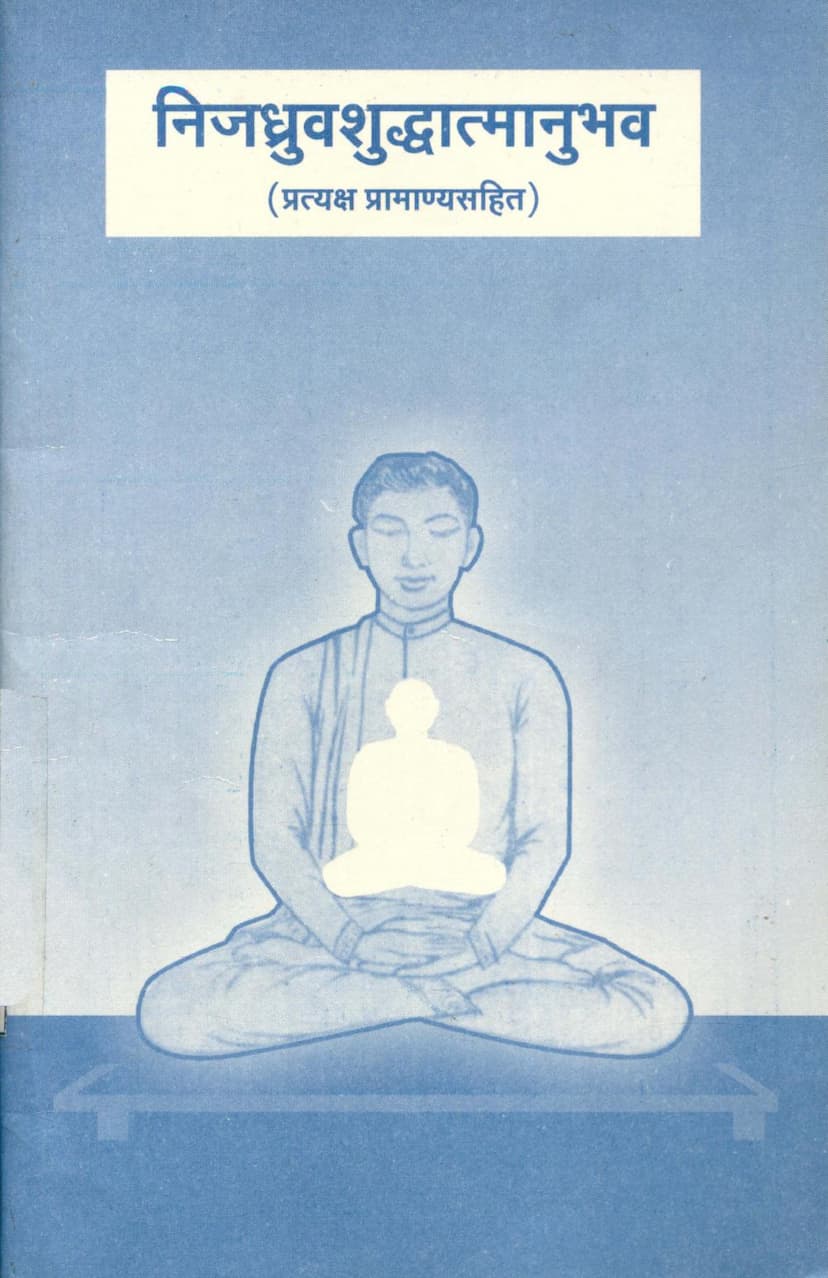Nijdhruvshuddhatmanubhav
Added to library: September 2, 2025

Summary
This document, titled "Nijdhruvshuddhatmanubhav" (Experiencing the True, Stable, Pure Soul), compiled by Lilavati Jain in memory of Acharya Shri 108 Veersagar Muni Maharaj, aims to establish that shuddhatmanubhava (pure soul-experience) or shuddhopayoga (pure consciousness) is attainable by householders (avrati grihasth) in the fourth gunasthan (stage of spiritual development), contradicting the notion held by some scholars and monks that it is exclusive to monks.
The book meticulously presents arguments supported by numerous scriptural references from various Jain texts and commentaries, aiming to resolve this debate. Here's a breakdown of the key points and themes:
Core Argument:
- Attainability of Pure Soul-Experience in the Fourth Gunasthan: The central thesis is that a householder who has attained samyaktva (right faith) in the fourth gunasthan can indeed have the direct experience of the pure soul. This experience is described as nirvikalpa jnana (undivided knowledge) and shuddhopayoga (pure consciousness).
Key Concepts and Distinctions:
- Types of Knowledge: The text differentiates between various types of knowledge, highlighting that only direct experience (pratyaksha pramanya) is considered true shuddhatmanubhava. Other forms like recollection (smaran jnana), recognition (pratyabhigyan), logical inference (tarka jnana), and inferential knowledge (anumana jnana) are deemed indirect or paroksha (indirect) knowledge and do not constitute the true experience of the pure soul.
- "This" vs. "That": The text uses the distinction between experiencing "this" (idanta) as direct experience and "that" (tatta) as recollection to explain the nature of immediate versus indirect knowledge.
- The Nature of the Soul: The soul is described as eternal, unchanging, conscious, blissful, and the essence of knowledge and perception. The goal is to realize this true nature, distinct from the transient states and experiences of the body and mind.
- The Role of Upayoga (Consciousness/Application): The text emphasizes that it is shuddhopayoga (pure application of consciousness) that leads to the realization of the fourth gunasthan. Shubhopayoga (auspicious application of consciousness) alone is not sufficient.
- Distinguishing True Experience from External Practices: The book strongly emphasizes that external rituals, penances, devotion, or adherence to vows are not the ultimate goal. The true experience of the soul (shuddhatmanubhava) is the ultimate aim. Actions performed without this inner realization are considered incomplete or even misleading.
Scriptural Support and Analysis:
- Extensive Quotations: The book draws heavily from texts like the Samaysar, Pravachansar, Niyamsar, Kartikeyanupreksha, Aptamimamsa, Ashtasahasri, Panchastikay, Brihad Dravya Sangraha, Jnarnava, Mahapurana, Tattvanushasan, Dhaval, and various commentaries.
- Jayasenacharya's Commentary: The commentaries of Jayasenacharya on Samaysar and Pravachansar are frequently cited to support the view that even those with attachment (saragi) in the fourth gunasthan can be considered samyadrishti (possessing right vision) and capable of experiencing the pure soul. The distinction between saraga svavedana (self-awareness with attachment) and vitaraga svavedana (self-awareness without attachment) is explored.
- Interpretation of Shastras: The text stresses the importance of understanding the intended meaning (nayavivaksha) of scriptural passages. It argues that a proper understanding of these nayas (perspectives) is crucial for correct spiritual insight.
Addressing Potential Misconceptions:
- Householders and Spiritual Attainment: The book directly challenges the idea that householders are inherently incapable of experiencing the pure soul. It highlights that true spiritual progress is about the inner state of consciousness, not external circumstances like being a monk or a householder.
- The Nature of Dharmadhyan and Shukladhyan: The text clarifies that both dharmadhyan (meditation on the nature of reality) and shukladhyan (pure meditation) involve the contemplation of the pure soul. While the intensity and duration might differ based on the spiritual stage, the object of meditation (the soul) remains the same. The householder's experience is described as a nascent form.
- The Importance of the "Pure Soul" as the Core: The book repeatedly emphasizes that any practice or understanding that does not lead to the realization of the pure soul is ultimately incomplete. External adherence to vows or rituals without this inner experience is considered a precursor or a means, not the end itself.
Purpose and Audience:
- Clarifying Confusion: The book aims to dispel confusion and provide clarity on a critical point of Jain philosophy.
- Encouraging Deeper Study: It encourages readers to study the scriptures with an open mind and to seek the true meaning behind the words.
- Honoring the Preceptor: The publication is dedicated to Acharya Veersagar Muni Maharaj, recognizing his profound spiritual insights and his role in bringing forth this understanding.
In essence, "Nijdhruvshuddhatmanubhav" argues that the direct experience of the pure soul is a fundamental aspect of Jain spiritual practice that is accessible to sincere householders, even in the fourth spiritual stage. It provides a detailed scriptural analysis to support this viewpoint, emphasizing the primacy of inner realization over external observance.